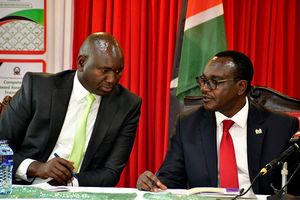
Kenya is racing against time to come up with a carbon pricing policy that might also include a new tax on fuel.
|Business
Premium
IMF’s fresh target for Kenya may come with new fuel tax
Kenya is racing against time to come up with a carbon pricing policy that might also include a new tax on fuel as part of fresh targets that have been set by the International Monetary Fund (IMF).
In its review of the programme it has with Kenya, the Bretton Woods Institution disclosed that by end of April next year, the National Treasury has committed to implement a new carbon pricing that will include the possibility of introducing a carbon tax and establish a carbon credit market.
The two are aimed at mitigating against the negative effects of fossil fuels including petrol, diesel and kerosene used by most of the businesses and individuals in Kenya.
Although the goal is to reduce greenhouse gas emissions, which scientists have blamed for global warming, a new carbon tax is likely to add to the pain of motorists at the pump.
“The authorities’ recent efforts to phase out subsidies and increase taxes on fossil fuels is helping Kenya achieve its mitigation goals,” said the IMF in its review of the programme.
“Going forward, possible options include introduction of a carbon tax or increase the excise tax on fossil fuels to better capture the externalities associated with fossil fuel consumption in line with recommendations from the IMF climate policy diagnostic mission,” the global financier added.
Motorists are already grappling with higher pump prices after the administration of President William Ruto decided to double the value-added tax (VAT) on fuel to the standard rate of 16 per cent.
Earlier, the Ruto administration removed subsidies on fuel, noting that it was not well-targeted and only benefited consumption by the rich.
The deadline for the possible introduction of a carbon tax, the IMF says, will be in April next year when, subject to Parliamentary approval, the National Treasury is expected to come up with carbon pricing.
Like many other recommendations it has proposed, the IMF expects the carbon tax will have a serious backlash.
According to the IMF, these carbon pricing options offers Kenya a double win: “They would help Kenya meet its mitigation goals while raising additional fiscal revenues, which could in turn be used to compensate vulnerable groups and offset the costs of higher energy prices.”
“A successful rollout of this reform will need to be accompanied by a well-planned communication strategy to clearly explain how revenue from higher carbon pricing reforms will be spent, including steps the authorities plan to take to mitigate adverse social impact of the reform,” said the IMF.
The doubling of VAT on petroleum products from eight per cent inflamed passions, with the country rocked by street protests that led to loss of lives and property valued at billions.
Reinstate fuel subsidies
Although the cost of living has generally gone down as prices of food—a major space taker in a typical Kenyan’s shopping basket—reduced, the prices of fuel have refused to come down.
As a result, the government was forced to reinstate fuel subsidies (the government calls price stabilisation) in a major U-turn as it moved to cushion consumers from skyrocketing pump prices.
The Energy regulator kept the prices of fuel unchanged in the August 14 price review cycle after reintroducing the subsidies that would have seen pump prices cross the Sh200 mark.
Joab Okanda, who insists that both the World Bank and IMF are not climate leaders, reckons the deadline being set by the IMF has been rushed.
“The government (of Kenya) is only developing its own carbon credit market,” said Mr Okanda, noting that some steps needed in policy-making process such as public participation might be bypassed.
Carbon taxes are designed to reduce greenhouse gas emissions such as carbon dioxide and methane by increasing prices of the fossil fuels that emit them when burned.
The increase in prices both decreases demand for goods and services that produce high emissions and incentivises making them less carbon-intensive.
Besides carbon taxes, the carbon pricing that Kenya is expected to develop will also include carbon credits and carbon offsets, which have also come under heavy criticism.
Proposed changes to the Climate Change Act, 2016, contained in the Climate Change (Amendment)Bill, 2023, seeks to set regulations for domestic carbon markets.
For instance, trading in carbon credits shall result from bilateral or multilateral agreements, a voluntary carbon market or trades with a private entity.
President Ruto has himself been preparing the country for inflow of billions of shillings through the carbon credit market as part of his plan to address food insecurity and climate change.
“To further enhance increase of financial flows for climate action, the government will develop and implement policies and strategies to tap into the global carbon market opportunities, green and climate financing mechanisms such as Green Climate Fund, promote green bonds and debt for climate swaps among others,” said the National Treasury in the Budget Policy Statement of 2023.
Carbon credit have been subjected to immense criticism, with critics noting that it is a way of giving rich countries the license to pollute.
Fossil fuels
And without alternatives to fossil fuels, especially for motorists, the introduction of carbon tax will be painful.
Most of the cars on the Kenyan roads today are propelled by internal combustion engines (ICE), a heat engine in which the combustion of a fuel occurs with an oxidiser.
The rising price of crude oil has made ICE cars and the fact that fossil fuels running them are major agents of global warming, has made ICE cars unpopular.
However, adoption of electric vehicles in the country has not picked up as the technology to enable widespread adoption of e-mobility is still costlier for developing countries like Kenya.
Revenues from carbon taxes and Emissions Trading Systems (ETS) hit a record high, about $95 billion (Sh13.7 trillion), according to the World Bank’s annual “State and Trends of Carbon Pricing” report that was released in May.
An ETS places a limit on the amount of greenhouse gas emissions – it allows emitters with lower emissions to sell their extra emission units (or “allowances”) to higher emitters, thereby establishing a market price for emissions.
A carbon tax, meanwhile, directly sets a price on carbon by defining a tax rate on emissions.
The World Bank noted that new ETS and Carbon Tax instruments were implemented in Austria and Indonesia, as well as in subnational jurisdictions in the United States and Mexico.
World Bank
Australia, said the World Bank, is scheduled to recommence carbon pricing with a rate-based ETS due to start in July 2023.
Chile, Malaysia, Vietnam, Thailand and Türkiye, the reported noted, continue to work towards implementing direct carbon pricing.
The World Bank noted that it has been tracking carbon markets for around two decades and the annual State and Trends of Carbon Pricing report is now in its tenth year.
According to the World Bank, when the first report was published a decade ago, only seven percent of global emissions were covered by either a carbon tax or an ETS.
Today, almost a quarter of global greenhouse gas emissions (23 percent) are now covered by 73 instruments.
Kenya is one of the 17 countries that had signed up for Joint Credit Mechanism before the Covid-19 pandemic. Others include Bangladesh, Cambodia, Chile, Costa Rica, Ethiopia, Indonesia, Laos, the Maldives, Mexico, Mongolia, Myanmar, Palau, the Philippines, Saudi Arabia, Thailand, and Vietnam.
Kenya has a bilateral agreement with Japan intended to establish the Joint Crediting Mechanism, which includes activities that pre-date the Paris Agreement.





